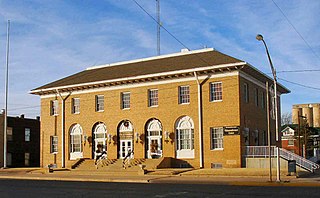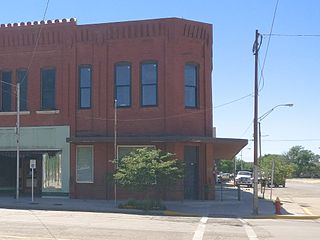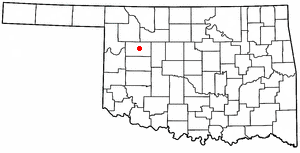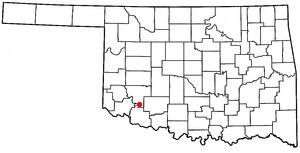
Woodward County is a county located in the U.S. state of Oklahoma. As of the 2020 census, the population was 20,470. Its county seat is Woodward.

Woods County is a county located in the northwestern part of the U.S. state of Oklahoma. As of the 2020 census, the population was 8,624. Its county seat is Alva. The county is named after Samuel Newitt Wood, a renowned Kansas populist.

Ellis County is a county located on the western border of the U.S. state of Oklahoma. As of the 2020 census, the population was 3,749, making it the fifth-least populous county in Oklahoma. Its county seat is Arnett.

Carbon County is a county located in the U.S. state of Montana. As of the 2020 census, the population was 10,473. Its county seat is Red Lodge.

Taloga is a town in Dewey County, Oklahoma, United States. The population was 288 at the time of the 2020 census.

Vici is a town in Dewey County, Oklahoma, United States. The population was 611 at the time of the 2020 census. No information appears on the origins of the town name, but Vici is Latin for “I conquered.”

Arnett is a town in and the county seat of Ellis County, Oklahoma, United States. The population was 495 at the time of the 2020 census.

Gage is a town in Ellis County, Oklahoma, United States. The population was 433 at the time of the 2020 census.

Shattuck is a town in Ellis County, Oklahoma, United States. The population was 1,249 at the time of the 2020 census, a change from the 1,356 reported in the 2010 census.

Breckinridge, sometimes spelled Breckenridge, is a town in Garfield County, Oklahoma, United States. The population was 199 as of the 2020 Census.

Buffalo is a town and county seat of Harper County, Oklahoma, United States. As of the 2020 census, the town’s population was 1,039. It was named after the Buffalo Creek valley, in which it is located.

May is a town in Harper County, Oklahoma, United States. As of the 2020 census, the town’s population was 29.

Snyder is a city in Kiowa County, Oklahoma, United States. The population was 1,394 at the 2010 census. This figure represented a decline of 7.6 percent from 1,509 persons in 2000.

Hitchita is a town in McIntosh County, Oklahoma, United States. The Encyclopedia of Oklahoma History and Culture says that the town was named for a band of Muskhogean Indians that had been absorbed into the Creek tribe. The population was 88 at the 2010 census, a decline of 22.1 percent from 113 in 2000.

Castle is a town in Okfuskee County, Oklahoma, United States. A post office was established February 25, 1903, and the town was named for the first postmaster, Manford B. Castle. The population was 169 at the 2020 Census.

Paden is a town in Okfuskee County, Oklahoma, United States. The population was 419 at the 2020 Census. It is named for Paden Tolbert, a U.S. Deputy Marshal who served the area in the early 1900s.

Peoria is a town in Ottawa County, Oklahoma, United States. It was named for the Peoria people, a tribe of Native Americans who were removed to Indian Territory from east of the Mississippi River during the 19th century. The territory had been occupied by the Quapaw people, who sold some of their land to the Peoria. The population was 131 at the 2010 U. S. Census, down from 141 at the 2000 census. The long decline of mining meant that jobs moved elsewhere.

Muldrow, officially the Town of Muldrow, is a town in Sequoyah County, Oklahoma, United States. It is part of the Fort Smith, Arkansas–Oklahoma Metropolitan Statistical Area. The population was 3,466 at the 2010 census, an increase of 11.7 percent over the figure of 3,104 recorded in 2000.

Manitou is a town in Tillman County, Oklahoma, United States. The population was 171 as of the 2020 United States census. It includes the former town of Siboney, absorbed on January 28, 1907.

Fort Supply is a town in Woodward County, Oklahoma, United States, 13 kilometres (8.1 mi) northwest of the city of Woodward, the county seat. The population was 330 at the 2010 census.













